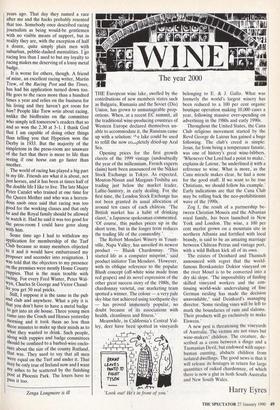The year 2000
THE European wine lake, swelled by the contributions of new members states such as Bulgaria, Rumania and the Soviet (Dis) Union, has grown to unmanageable prop- ortions. When, at a recent EC summit, all the traditional wine-producing countries of Western Europe declared themselves un- able to accommodate it, the Russians came up with a solution: ",e lake could be used to refill the now co..,pletely dried-up Aral Sea.
Opening prices for the first growth clarets of the 1999 vintage (undoubtedly the year of the millennium, French experts claim) have been announced on the Nikkei Stock Exchange in Tokyo. As expected, Mouton-Nissan and Margaux-Toshiba are trading just below the market leader, Lafite-Suntory, in early dealing. For the first time, the London Stock Exchange has not been granted its usual allocation of around ten cases of each chateau. The British market has a habit of drinking claret,' a Japanese spokesman commented. 'Of course, this pushes prices up in the short term, but in the longer term reduces the trading life of the commodity.'
The Robert Mondavi Winery in Yount- ville, Napa Valley, has unveiled its newest product — Bluish Chardonnay. 'This started life as a computer misprint,' said product initiator Tim Mondavi. 'However, with its oblique reference to the popular Blush concept (off-white wine made from red grapes) and its novel expression of the other great success story of the 1980s, the chardonnay varietal, our marketing team spotted a winner. The colour — a very pale sky-blue tint achieved using toothpaste dye — has proved immensely popular, no doubt because of its associations with health, cleanliness and fitness.'
Meanwhile, in California's Central Val- ley, deer have been spotted in vineyards 'Look out! He's in front of you.' belonging to E. & J. Gallo. What was formerly the world's largest winery has been reduced to a 100 per cent organic boutique operation making 10,000 cases a year, following massive over-spending on advertising in the 1980s and early 1990s.
Throughout the United States, the Cana Club religious movement started by the Revd George de Latour has gained a huge following. The club's creed is simple: Jesus, far from being a temperance fanatic, was one of history's great wine-bibbers.
'Whenever Our Lord had a point to make,' explains de Latour, 'he underlined it with a reference to wine. What is more," as the Cana miracle makes clear, he had a nose for the good stuff. If we want to be true Christians, we should follow his example.'
Early indications are that the Cana Club may be rolling back the neo-prohibitionist wave of the 1990s. • Zog I, the result of a partnership be- tween Christian Moueix and the Albanian royal family, has been launched in New York and London. The wine, a 100 per cent merlot grown on a mountain site in northern Albania and fortified with local brandy, is said to be an amazing marriage between Château Petrus and vintage port, with a wild Balkan kick all of its own.
The estates of Deinhard and Thanisch announced with regret that the world- famous Bernkasteler Doktor vineyard on the river Mosel is to be converted into a dry ski slope. 'The impossibility of finding skilled vineyard workers and the con- tinuing world-wide undervaluing of fine German riesling has made the decision unavoidable,' said Deinhard's managing director. 'Some riesling vines will be left to mark the boundaries of runs and slaloms. Their products will go exclusively to make Eiswein.' • A new pest is threatening the vineyards of Australia. The victims are not vines but wine-makers' children. The creature, de- scribed as a cross between a dingo and a Tasmanian Devil, but endowed with super- human cunning, abducts children front
isolated dwellings. The good news is that it will release its hostages in return for large
quantities of oaked chardonnay, of which there is now a glut in both South Australia and New South Wales.
Harry Eyres


























































 Previous page
Previous page